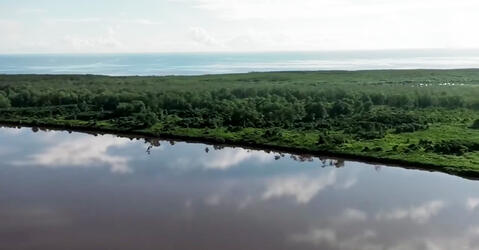You are here
Little Foot
Under shining headlamps, the caves of Sterkfontein reveal their imposing depths. Mere kilometers from Johannesburg, South Africa, this has been one of Laurent Bruxelles’ geomorphic research sites for over ten years. This cave was formed five million years ago. Exploitation by mining companies, in the early 20th century, led to the discovery of a treasure: the remains of an Australopithecus. At the bottom of this cave, a team of paleoanthropologists made an exceptional discovery: a nearly complete skeleton, they named “Little Foot.”
Laurent Bruxelles – Geomorphologist
He was here, we could see the base of his skull, and there was a humerus underneath. The left arm was outstretched with its hand closed around its thumb. There was a bit of a collapse on the sides here, which left the vertebrae and pelvis mixed up, and higher, we have the femurs and parts of the tibia which were broken. It’s this exact spot that Ron Clarke’s team found and located the broken tibia. We have to imagine that when they found these fossils, in an era before all this was excavated, there was a wall here, and the whole mine would have been dynamited. So they came really close to Little Foot, thankfully stopping at his feet.
How was this body trapped down here to begin with? Bruxelles’ team believes Little Foot must have fallen over 30 meters from the surface, and that the atmosphere and geology of the cave preserved his skeleton. On the surface, the countryside probably resembles what Little Foot would find familiar. The 47,000 hectares of this site contain the most concentrated collection of ancient hominins discovered in the African continent. An exceptional density which earned Sterkfontein the title “Cradle of Humanity” by UNESCO in 1999. These fossils cover a period ranging from 1-4 million years ago, during which time the Homo genus, our first direct ancestors, appeared on the Earth.
Laurent Bruxelles
As we reflected on the origins of humanity, and on the notions of our birthplace, East Africa held the strongest thread running between ancient fossils and the appearance of the Homo genus. Until now South Africa was considered way too young. The oldest fossils here were dated at 2.2 million years old. When we found Little Foot we reran our dating based on the stratigraphy and found he was 3.7 million years old, which begins to reshape South Africa’s history into something resembling East Africa’s. There’s suddenly no reason to think that hominins couldn’t have been anywhere. It’s just that until now, we hadn’t come across such a geological trap.
To place ourselves in the hominin story, the group of large apes we belong to, Laurent Bruxelles collaborated with Ron Clarke, the paleoanthropologist who discovered Little Foot. In a hangar located in Sterkfontein, Professor Clarke continues these excavations to place Little Foot within humanity’s timeline. Thanks to Bruxelles’ geological analysis, he was able to date Little Foot at 3.7 million years old. But to learn more about this Australopithecus, he would need to look more closely at its skeleton.
Contained in the basements of Wits University in Johannesberg: a vault-like room. Here lie the most precious fossils discovered in South Africa, including those of Little Foot. It was the discovery of a lost fragment of foot within this collection that enabled Ron Clarke to discover this skeleton within the cave of Sterkfontein. In less than two days, his team succeeded in rediscovering the bone fragment, and led to the discovery of the entire skeleton.
Unlike the famous skeleton of Lucy, with only 40% of the bones preserved, Little Foot’s is considered complete at over 95%, giving us a fuller picture with the skull, limbs, and even the left hand intact.
Ron Clarke – Paleoanthropologist
After cleaning the skull, I was able to see indications of the individual’s age by her heavily worn teeth. It seems probable that she was older, probably between 30 and 40 years if we compare her to modern primates. She seems to have been on the smaller side, perhaps 1.3m, and I was able to determine that she was probably female.
The other interesting thing is that the morphology of the skull appeared to be of a second species of Australopithecus. Thus in Sterkfontein, we had the fossils of Australopithecus Africanus alongside the fossils of this second, Australopithecus Prometheus.
Beyond details like her diet, this Australopithecus Prometheus reveals some small secrets about her cognitive abilities. This is the work of researcher Amelie Beaudet, who uses advanced technology to dive into the brain of Little Foot. Wits University is equipped with a micro-tomographic scanner which enables the discovery of minute details within her skull. These images reveal the bone and sediment included within the cranial vault, along with the imprint left by the brain on the internal surface. Thanks to this data, Amelie Beaudet developed an endo-skull, a 3D model of the cranial cavity which enabled scientists to create a replica of Little Foot’s cerebral structure.
Amelie Beaudet
We’ve observed a number of imprints of Little Foot’s endocranium, notably on the anterior part of the brain, the frontal lobes. A lot of the imprints we can see can be compared to other hominin fossils, particularly other Australopithecus. And we see a structural similarity between Little Foot and more recent Australopithecus. On the other hand, for the posterior which looks like what we call the occipital, we can see a notable difference within the structure of her visual cortex. This is an important detail we’ll explore. Why is it that we don’t find this structure, that’s over 3 million years old, in the Australopithecus who are closer to actual humans today.
Clearly these details merit further investigation ; and we will be using our 3D models to study this.
Advances in technology will enable an even deeper analysis of this nearly 4 million year old skeleton. The discovery of Little Foot has paved the way for new geological surveys. In identifying other sites with similar geological characteristics to Sterkfontein throughout southern Africa, scientists could discover the fossils of yet more ensnared bodies. The trapped clues to retracing the story of humanity’.
Little Foot's Brain
Discovered in the 1990s, Little Foot is the most complete skeleton of an Australopithecus ever unearthed. Research continues on this exceptional fossil as scientists reveal details about her cognitive abilities using a micro-tomographic scanner.





